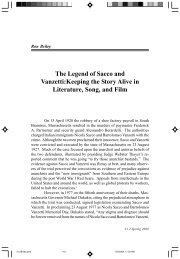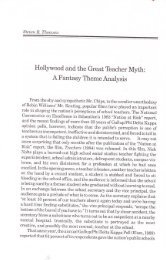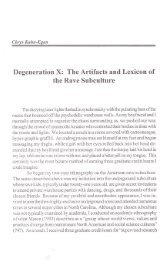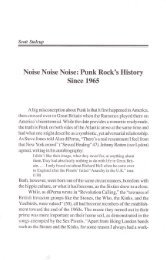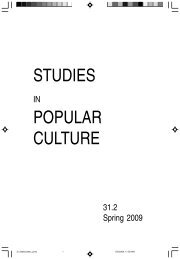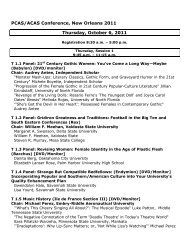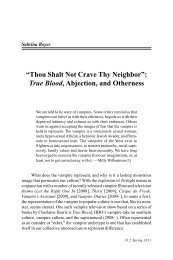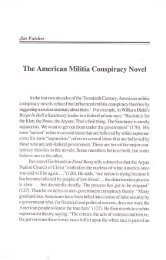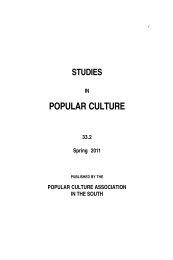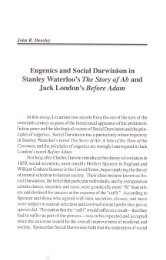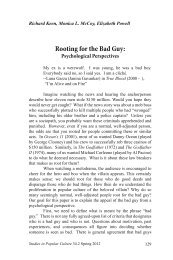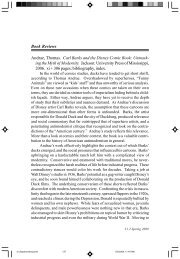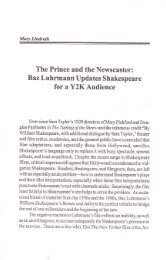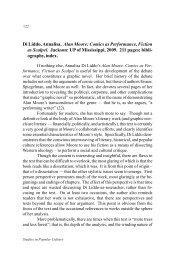'Sigmund Freud, Analyze This': How Madonna Situates - Popular ...
'Sigmund Freud, Analyze This': How Madonna Situates - Popular ...
'Sigmund Freud, Analyze This': How Madonna Situates - Popular ...
You also want an ePaper? Increase the reach of your titles
YUMPU automatically turns print PDFs into web optimized ePapers that Google loves.
88 David Sigler<br />
o”: “o-o-o-o” being the small child’s utterance that <strong>Freud</strong> interprets as<br />
“Fort!,” or “gone!” (<strong>Freud</strong> SE XVIII: 15). This is supported by the music<br />
video, in which <strong>Madonna</strong> grabs a razor-edged hat (one of the accoutrements<br />
of Bond villainy) and throws it away. “Gone!” she announces with<br />
her “uh uh,” just as she sends the hat away in a pleasurable display of<br />
mastery. A children’s game: is this gesture not the fulfillment of her promise<br />
earlier in the song to find “A time to work, a time to play?” In <strong>Freud</strong>’s<br />
account, children’s games such as fort-da are the very processes by which<br />
we master and negotiate trauma and initiate repetition compulsion. And<br />
so it seems almost inevitable that <strong>Madonna</strong>’s very next utterance assumes<br />
the position of the analysand (“I need to lay down”) and then, by transference,<br />
gets locked into an interminable compulsion to repeat: all she can<br />
say for the remainder of the song are variations of “I guess I’ll die another<br />
day” and nothing else. Moreover, the disco-style drum machine, which<br />
through most of the song has enjoyed intermittent rests, now remains uninterrupted;<br />
but even it is survived by the seemingly indefatigable syncopated<br />
string arrangement caught in an endless loop of repetition that outlasts<br />
all of the other instruments. 13 According to <strong>Freud</strong>, fixations about death<br />
(or, as he puts it, “involving a risk to life”) approach hysteria in the “wealth”<br />
of their symptoms, but also stretch somewhere beyond hysteria,<br />
“surpass[ing] it as a rule” (SE XVIII:12).<br />
<strong>Freud</strong> takes it upon himself to limit the repetitive utterances that<br />
can emerge from such situations: he accepts that it is “the physician’s<br />
endeavor to keep this transference neurosis within the narrowest limits: to<br />
force as much as possible the channel of memory and to allow as little as<br />
possible to emerge as repetition” (SE XVIII: 19). But <strong>Madonna</strong> has<br />
already pointed her own way out of this fixation, and thus has indeed<br />
“found another way”: her earlier promises to “close my body now” and<br />
“suspend my senses” are fulfilled through her scenes of binding from the<br />
music video, as described above. <strong>Freud</strong>, like <strong>Madonna</strong>, would have the<br />
organism close its body by a process of binding so as to suspend its<br />
senses; thus binding, somatic closing, and sensory suspension are intimately<br />
linked processes in <strong>Madonna</strong> and <strong>Freud</strong> alike. In section IV of<br />
Studies in <strong>Popular</strong> Culture



